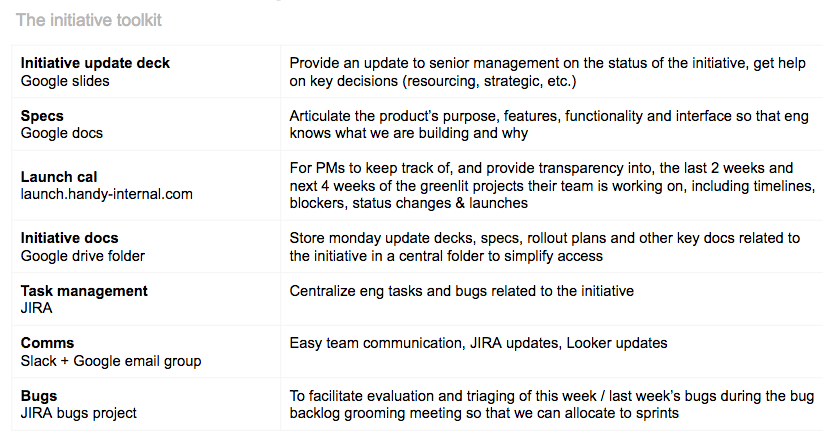In 2012, my Harvard Business School classmates Oisin Hanrahan and Umang Dua created a company called Handybook from their dorm room. The idea was simple: they wanted to make booking house cleaners and home repair professionals as simple as ordering from Seamless. While I went off to work as a product manager at Amazon after graduation, Oisin and Umang stayed busy building the company.

Umang Dua and Oisin Hanrahan
Like many young companies facing hyper-growth, Handy was faced with a number of tough decisions, including one to shift our cleaning business from on-demand to subscription. This required a company culture that supported quick direction changes via extreme focus and iterative testing.
It occurred to me that the success of our product externally was highly dependent on the environment that we fostered internally, and that culture was much more than free lunches, and a keg; a common misconception that permeated the Valley. We found that the culture that resonated the most with our team was one that provided challenges, opportunities to add value, and continual growth.
With this in mind, it was important to build a product culture that not only fostered professional growth, but also one that ensured our organization was able to build our product quickly and iterate effectively. The structure that we put in place segmented our product organization by initiative instead of domain expertise, and also called for continuous and frequent feedback.
Unconventional – but impactful – team organization
One value that has been particularly successful in this mission is our focus on rewarding success with new challenges, responsibility, and career direction.
When we organized our product team, we chose to take a somewhat non-traditional route to support this particular value. We don’t align product managers to domain areas of our product, such as “Customer”, “Pro”, “Marketplace”, “Internal Tools”, etc. Instead, we dedicate teams to one of a handful of high impact initiatives that are chosen as the focus for the quarter. These initiatives usually drive immediate and meaningful change in the business.
[su_pullquote align=”right”]Where possible, PMs don’t just own the product experience and input metrics associated with their initiative, but they also own the P&L.[/su_pullquote]
Within this initiative structure we organize PM-lead cross-functional teams that are comprised of design, engineering, ops and marketing. Each team focuses on a given metric and problem area, and is responsible for developing and owning their roadmap within that initiative scope, while also delivering results. Additionally, where possible, PMs don’t just own the product experience and input metrics associated with their initiative, but they also own the P&L.
This approach not only ensures that our teams are dedicating their time to projects that are likely to make a meaningful difference to our growth and success, but it also promotes maximum flexibility and learning opportunities for PMs and designers. As PMs get wins under their belt, they are rewarded with the bigger, hairier initiatives that are more amorphous and require larger engineering teams.

Ramp Up Quickly, Roadmap Often, Iterate Effectively
Figuring out how to quickly go from strategy to code to user experience in a completely new domain area is not easy. Three years into operating this initiative model, we now have a system in place that better supports teams for success. Frequent, reliable feedback is critical to executing productive product iterations.
At Handy, we hold a lot of meetings. More specifically, monthly roadmap meetings help us align on vision, the underpinning user research, analytics as well as the ideation that support that direction. All-hands meetings provide an opportunity for teams to evangelize their projects and rally the company to support them. Weekly meetings and daily office hours help us stay on top of our goals to ensure impact and speedy completion of deliverables.
Through these meetings we are given multiple opportunities to describe challenges to each other, collaborate and get ideas from team members with different perspectives on how to overcome them.

The meetings and initiative toolkits we rely on have not only been instrumental in providing opportunities for collaboration, and growth, they’ve helped us us maintain a necessary level of transparency as well.
And, I think this is really important. A transparent organization is conducive to open communication and company alignment. This is especially useful when expanding capabilities and your product. For example, this was critical for us as we expanded our product beyond our well-known cleaning business into retail.
Until last year, Handy’s platform was a purely direct-to-consumer product; meaning, you could only access our service through our site or app. Today, we’re also available to customers in 2,000 Walmart stores across the U.S and on Wayfair.com. Customers of these retailers can purchase assembly and installation services from a Handy Pro right as they check out. As you can imagine, these partnerships opened doors for us but also required us to be able to effectively build and quickly iterate.
For our PM’s, who were assigned to this initiative, our initiative-based organization and meetings structure helped them quickly identify, seize and execute against opportunities. They were not only exposed to more product learning opportunities (APIs, in-store product, etc.), their professional growth was also transformative for our business and product as we were able to accommodate the level of growth that came with each of our partnerships. And, I think this is the holy-grail – company and employee success that works in tandem.
Onward and Upward
What started in a Harvard Business School dorm room, is now a profitable company whose product is used by more than half a million people across 2,000 cities in the U.S. and we are still building and expanding.
Early on we recognized that to achieve our mission, we would have to build not only an amazing product but also an amazing team, and the culture pillars we’ve put into place have been key to us achieving our goals.

